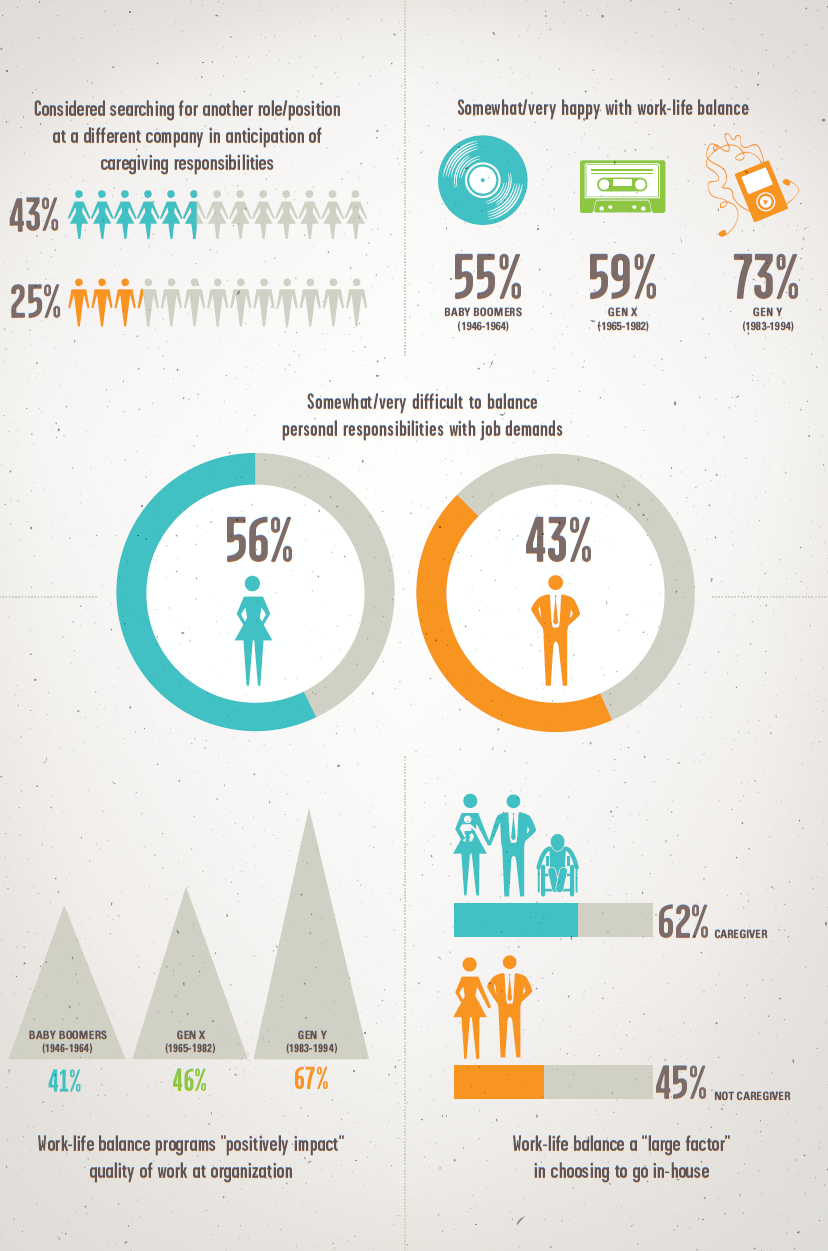
CHEAT SHEET
- It’s universal. The global, constantly connected and multigenerational workforce, and the unique mix of generations in the workplace, has never been greater. And, the scale is leaning toward more balance, not less.
- It’s culturally specific. The availability of unplug time is usually indicative of a flexible workplace culture.
- It’s not easy. There is a disconnect between perceptions of benefits and ability to access them. Most feel telecommuting and flexible work hours are very helpful but fewer are comfortable using them.
- It’s possible. A goal that managers may strive for is that nearly every worker feels empowered to make decisions regarding work and personal life that help balance responsibilities, and enable a measure of success at both.
Some might suggest sunlight plays a role in the ability to handle work and personal demands. Indeed, most humans depend on sun exposure to satisfy their requirements for vitamin D, and lack of vitamin D may be one of the factors that contributes to a depressed mood. While the 2014 Global Work-Life Balance Report did not dissect work-life balance from this angle, regional differences (we spoke with in-house counsel around the world, from Boston to Brazil) concerning attitudes about how to stay centered on the seesaw of life certainly exist.
Work-life balance means something different to individuals and can vary across generations, stage in career and life, and more. This article explores those differences and offers some best practices, as well as insights and recommendations to managers on how to encourage equilibrium.
It’s universal, sort of
The global, constantly connected and multigenerational workforce, and the unique mix of generations in the workplace, has never been greater. And, the scale is leaning toward more balance, not less.
As mentioned earlier, the manner in which individuals integrate balance differs. Some respondents to the report described work-life equilibrium as the ability to sometimes unplug. Lisa Seilheimer, senior corporate counsel at CDW, articulated a personal story in a way that makes this point:
As a lawyer, you have to learn when it’s appropriate to “turn off the switch.” Otherwise there is really no limit to how much you can work or be thinking about work — especially when most of us have at least two mobile devices, often more, and can be emailed, paged, texted, pinged or called at any time.
For example, I recently went to Miami for a triathlon and took a long weekend away from work. I remember going to the beach after the race and taking my laptop with me — to catch up on work. I remember positioning the beach umbrella to try to minimize the glare from the bright sun on my screen, dusting off the laptop as the sand blew onto the keys, trying to make sure I didn’t get sunscreen on the laptop and fighting intermittent wireless access from the hotel. Then, I realized I couldn’t even go swim in the ocean because I couldn’t leave the laptop unattended. After much ado to accomplish nothing, I realized this was not the time or the place for work — it was ridiculous, and I should take the laptop back up to my room. I should just take a few hours, unwind after the triathlon and enjoy the beach instead of trying to respond at that very minute to a deluge of emails.
Some might argue that work-life balance is an impossible reality because most companies operate on a global scale, serving clients and connecting with colleagues who might be separated by oceans and time zones. When asked if work-life balance is truly achievable Seilheimer replied:
Work is a huge part of my life — many of my life goals have centered on building a successful career. So I don’t really draw much of a distinction between work and life — they are one in the same for me. It’s life and life, not work and life. Being happy and fulfilled at work goes a long way to having a happy and balanced life, seven days a week. I’m fortunate that I’ve been able to build a career that allows me to have a life I enjoy seven days a week, instead of living for the weekends.
Jaime L. Genua, vice president and senior counsel at Massachusetts Mutual Life Insurance Company (MassMutual), also weighed in on this question:
To me, it’s not necessarily about balance because balance is never going to feel like an attainable goal for someone who has competing family and work demands. Having work-life flexibility to assist with reducing the angst associated with this tug-of-war better captures the goal. As a baseline, this requires having the proper support system in place. This support has to consist of a manager who listens and works with you at times when family needs are in high demand, clients who trust that you will be responsive to their needs but recognize that there may be, in certain circumstances, a time delay in that response and a support system at home that will pick up the slack when the workload requires more than its usual amount of attention.
Shaka Johnson, legal director at Sony Inc., also believes work-life balance is achievable:
We work very hard. We’re at work sometimes as much as we’re at home. It’s a difficult balance to maintain because work takes such a priority in our lives, and a lot of us are driven to be successful at everything, whether it’s a weekend hobby or a work project. Nevertheless, everything I do I try to evaluate the impact it will have on my family. I’ve been married for about 3 ½ years. We have an eight-month old. It’s tough. Getting home at 6:45 pm gives me very little time with the baby, and I’m still trying to figure out how to do my job well while also meeting the demands of being a father and a husband.
It’s culturally specific
The availability of unplug time is usually indicative of a flexible workplace culture. MassMutual is taking steps to increase employee engagement. A June 2014 Work-Life Integration survey conducted internally at the company showed that finding a healthy equilibrium between work and personal time is not a gender-specific issue. Seventy-three percent of women and 71 percent of men stated that they agree or strongly agree with the statement: “I am able to maintain a healthy balance between my work and personal life.”
The leadership team at Mass Mutual used this data to develop an action plan with key areas of focus: (1) level of work, (2) interruptions during evening and weekends, (3) interruption during vacations, and (4) flexible work arrangements.
Genua also commented on her workplace environment:
For a company to be truly supportive of work-life balance, it has to start at the top. At MassMutual, we are treated like professionals, meaning if we get the work done and done well, then there is little scrutiny on where we get it done or during what hours. Our general counsel has made that clear in his communications to the law department and he expects his direct reports to adopt the same message. While he doesn’t necessarily model the behavior (which he is the first to admit!), he is incredibly receptive to hearing new ideas about how work-life balance can be encouraged and supported. So having a leadership team that openly supports work-life balance and actively engages in a dialog about it is paramount. This means not only permitting flexible working arrangements, but also recognizing that those who take advantage of it should not be penalized in terms of advancement opportunities.
The legal department at Sony Inc. also offers flexible work arrangements. Johnson shared his perspective on using telecommuting as an option to gain work-life balance:
My company is very flexible when it comes to telecommuting and being able to get on the network from home. I enjoy having the option, but I actually don’t like working from home as much as you’d think. For me, there’s a physical separation between my work and my home life. When I’m at home I want to feel relaxed and comfortable and enjoy my time and not be thinking about the work I have to do. That said, if I have to I will work from home after the baby goes to bed. This way I can get home early enough to enjoy time with my wife and daughter and still do the stuff that absolutely needs to get done before the clock strikes midnight.
Not all workplaces offer such arrangements. Having been in an environment that did not encourage flexibility, Rafael Barreto Garcia, chief legal officer at CEITEC Semiconductors, discussed how his prior work situation shaped his perspective:
Today I am able to see and confirm that work-life balance is essential for a successful working atmosphere. Of course not everyone knows how to enjoy it properly, and sometimes you find some “sneaky lazy” ones who are not fully committed to their team. But it is the role of the manager to know the ones who value flexibility in exchange for more commitment to the team/company. This must be a win-win scheme. Otherwise, it will not work. The challenge of the manager is to keep encouraging staff to do the work and be open to negotiating deadlines, absences and the like. Everything is negotiable!
In keeping with his nuanced leadership style, Garcia does the following as a way to encourage his staff:
I encourage my staff to be able to do job sharing or telecommuting (especially the in-house “moms”). I have back up when taking sick leaves. And I always try to prepare my staff to be able to be in my position if needed. I have learned that no one is (un)substitutable. A belief to the contrary is bad for everyone. If I believed no one on my staff could do any task of my job, then I would never take vacations or have time for personal commitments.
The type of leadership Garcia espouses is precisely the kind needed to maintain not only an engaged workforce but also a diverse one. Sixty-two of the survey participants who identified themselves as member of a minority or underrepresented group said that work-life balance was a large factor in their decision to choose an in-house position.
A 2015 study by McKinsey confirms that organizations dedicated to leadership diversity are more profitable and this trend is global. Gender diversity equates to higher profits by a wide margin. Companies with greater gender diversity in leadership were 15 percent more likely to report financial returns above their national industry median. Sales revenues decline with a homogenous workforce. Organizations with lower racial diversity have, on average, $51.9 million in sales revenue versus $761.3 million in highly diverse organizations.
It’s not easy
ACC research illustrates the relationship between perceptions of work-life balance and turnover with 55 percent of in-house counsel surveyed saying that work-life balance was a large factor in their decision to go in-house, and nearly all said it was least a factor to some degree (90 percent). Yet, one in three in-house counsel are considering leaving their job in anticipation of, or because, they are caregivers/working parents.
As expected, those finding it easier to manage work-life balance were significantly less likely to say they’d consider leaving their job or company. Flexibility and telecommuting options aimed at balancing work and personal commitments have an especially big impact on whether or not lawyers who are caregivers are considering changing jobs or roles. Significantly fewer lawyers who are caregivers reported likelihood to make a job change when they work in a company with flexible work schedule or telecommuting options offered. Just over half reported being happy with their current work-life balance, indicating there is room for improvement to not just offer, but encourage the use of benefits aimed at easing the challenges associated with managing everything in a technologically advanced but constantly connected environment.
Employers should pay attention because the impact on the bottom line has also never been clearer. The cost of losing a valued employee is estimated at between 1.5 and 5 times the salary of the individual and for in-house counsel with specialized training, the figure can be even higher. The impact on others, including picking up additional work and a decline in morale, makes
turnover costly, to say the least. In today’s in-house law department, navigating these challenges is important for leaders and employees. A few questions to consider include the following:
- How can employees draw boundaries between the desire to be a responsive and successful lawyer and having a fulfilling personal life?
- And, as a leader striving to meet client needs and drive a performance culture, how can one retain a talented workforce and support them holistically, without driving employees to choose between their job and their personal life?
There is a disconnect between in-house perceptions of benefits and the ability to access them. Most feel telecommuting and flexible work hours are very helpful but fewer are comfortable using them. Seventy-eight percent of in-house counsel who responded to the 2014 Global Work-Life Balance Report indicated telecommuting and a flexible work schedule would be helpful, yet roughly one in three would not be totally comfortable using these programs. Shaka Johnson, legal director at Sony Inc., noted that although flexibility is attainable, he wrestles with his own standards when it comes to using them.
One thing I’ve seen people do that I have not implemented (although I think it would work if I did it) is to leave the office at 5. They are very clear about leaving at this time, and they’re available later in the evening if necessary. Everyone I’ve seen do that has done it successfully. There’s that fear we all have that if we leave early we’ll be looked down on. I’ve never seen that happen though. I haven’t done it yet because I still am accustomed to working until I’m done, and I also have that fear that if a big project comes along I won’t be included because I’ll be seen as someone who can’t be relied on to be there if really needed. I think it’s something that could work though. It’s just a matter of setting the expectation.
It’s possible
What can be done? For starters, recognize that time spent in the office does not equate to performance for all employees, and flexibility and telecommuniting have the power to reduce stress and strain on the workforce.
Further, accepting that the plugged-in Millennials will expect to be wireless and working is a first step to retaining them. Educate senior staff, create accountability channels that ensure high-quality work, and focus on outcomes, not howcomes. Or, as Garcia puts it: “Value job performance rather than amount of time spent in the office.” Recognize that formal efforts to attract, mentor and promote a diverse leadership has an impact on the bottom line, but takes conscious effort. Reducing the challenges associated with caregiving by providing flexibility is likely to have a great impact. Seventy percent of women reported that being a caregiver has had a negative influence on their career advancement compared with just 38 percent of men, and diverse lawyers were more likely to say work-life balance had a significant impact on their decision to go in-house. Programs designed to capitalize on a diverse workforce may benefit significantly from a focus on enhancing their ability to manage their work and personal commitments to maximize performance.
How we address our balance is up to us as long as the impact is positive on work, the business and the bottom line. While every one may not be 100 percent comfortable leaving work in all situations, a goal that managers may strive for is to encourage nearly every worker to feel empowered to make decisions regarding work and personal life – helping to balance responsibilities and enable a measure of success at both – without sacrificing self.
Johnson shared his reason for joining an in-house legal team:
It was a decision that I thought would benefit me from a work-life balance perspective, but the main reason was because I really enjoy a business approach to the law. I really enjoy having a consistent objective and a team-oriented perspective on what I’m doing. When you’re in a firm, you can get to a point where you feel like you’re a mercenary for the client of the day. And you work very hard for that particular client to “win” in the short term. Working in-house, you can take a much longer-term perspective. You’re not just trying to win the day, or the battle. You’re trying to win the end game: the war. And you’re trying to do things to set your company up for future success.
If we expand the definition of work-life balance to mean valuing engagement, organic motivation, and not artificial limitations and policies that keep people plugged in 24/7, then we can see that it’s the reason most moved in-house, and it’s certainly worth fighting for.





